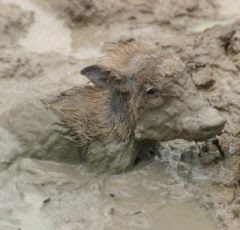 Worldwide bee populations are plummeting mostly due to the introduction of non-native types into foriegn habitats. Throughout history the health and survival many lifeforms, including bees, have been protected by geographical barriers. Here in N. America the oceans and the mountain ranges have served to isolate different bee populations from the diseases circulating in other distant areas. The effect being that in some areas bees thrive in others they die back.
Worldwide bee populations are plummeting mostly due to the introduction of non-native types into foriegn habitats. Throughout history the health and survival many lifeforms, including bees, have been protected by geographical barriers. Here in N. America the oceans and the mountain ranges have served to isolate different bee populations from the diseases circulating in other distant areas. The effect being that in some areas bees thrive in others they die back. Things have changed, in the last 100 years global transportation and industrial agriculture have conspired to wipeout the barriers that once protected native bee populations in their far flung habitats. Wherever you live, however you live, rich or poor, your food supply is only safe if the bees are too. 80% of our food depends on pollinators to mature, of the pollinators bees comprise the vast majority. Bee health equals food security.
The bees are also under pressure from climate change, the natural range of the different types is on the move away from the equator in each hemisphere. Plus the bee's predators are on the move. Many different mites and infectious agents once contained by geography and climate conditions are wiping out bees worldwide. Another climate driven factor in bee survival is the changes in flowering times for plants as the climate regions shift. Bee's need certain tempratures before they become active, plants are mostly photoactive meaning they respond to the number of hours of light to cue their growth and flowering cycles. For millenia the bees and the flora in their region have evolved a symbiotic partnership based on the timing of each other's needs.
In many areas the first high nector flowers the bees have collected from each season haven't opened yet when the bees first awaken each year. It's warm enough for the bees earlier than it used to be but for the plants, drawing their cues from the hours of sunlight, it's still to early. That's where chives come in. Chives flower very early in all regions, conditions and climates. They flower based on maturity and pruning practices. Chives are open and covered is sticky, stinky, nector before the bees wake up. This first big feed for the bees is fundamental to their early honey production, their yearly honey storage and their survival. The bees descend on your chives early, they return each day for more nector and gradually move out to pollinate the rest of your garden and surrounding wildflowers. We and the bees are partners, by planting chives johnny appleseed like we all benfit.
I'm a seed saver, last year the bees and chive plants produced thousands of mautre seed which i've collected and stored. I'll gladly give away enough chive seed to get you started into this cycle. If you live here on the Sunshine Coast of BC i'll deliver the seed to you directly, if you live somewhere else be sure to include your mailing address in your email. Chives are a delecious high vitamen green that add a spicy treat to every dish. Once planted chives regrow each year bigger and better than the year before. Miraculous for man and bees alike.


